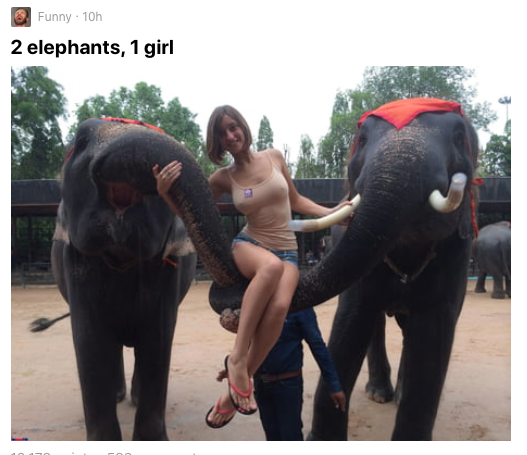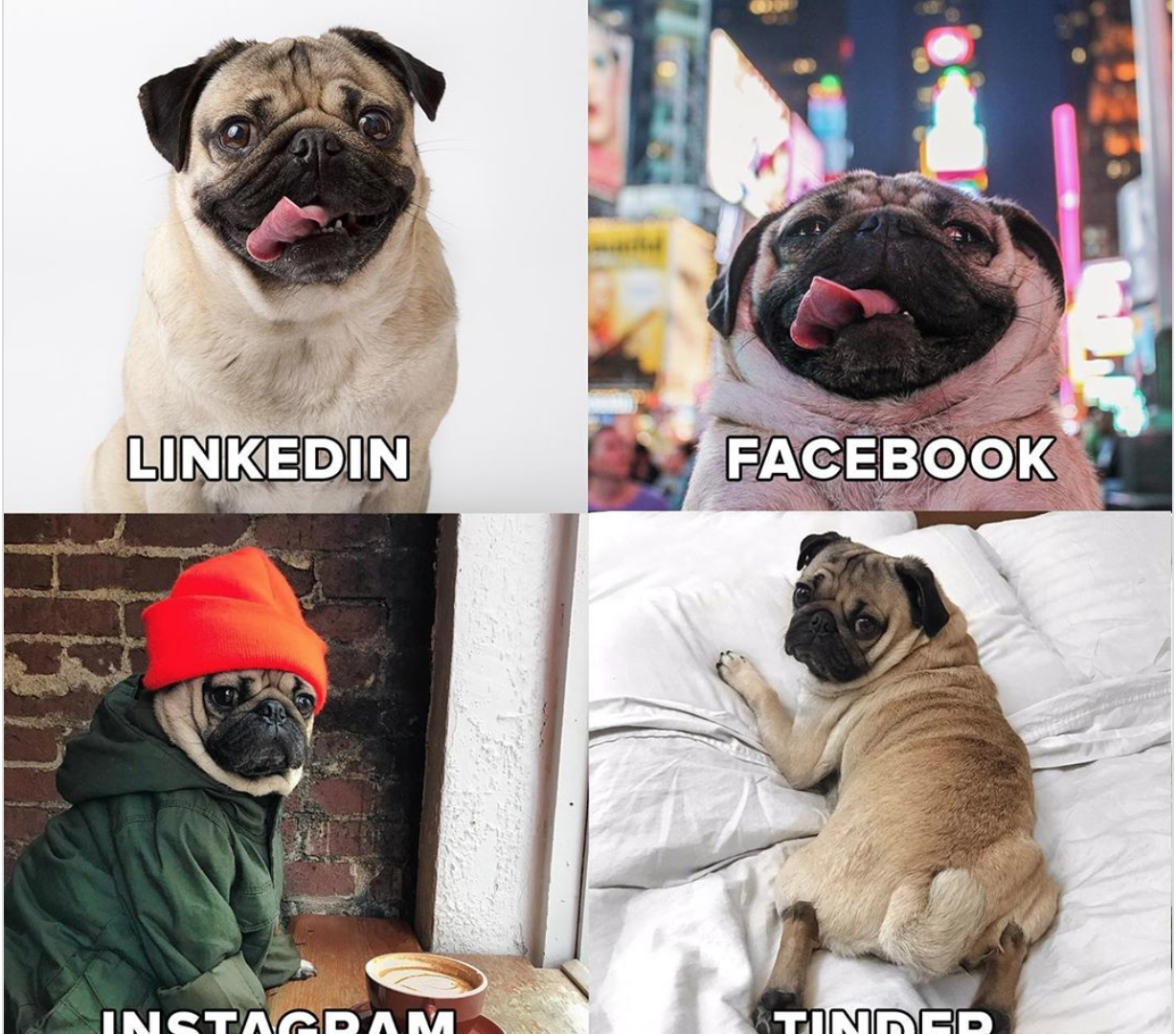9GAG is a media sharing website where users gather to upload and share mostly user generated content through the form of memes. It was created by Ray Chan, a Hong-Kong based business man in 2008 as a platform for users to share funny photos and videos (Escher, 2017). The platform is designed to emphasize and encourage media sharing in the form of photos and videos, created by users -or found by them on other social media sites.
The way that the platform works relies heavily on user ‘labor’. The community – as Chan calls it – is the main filter for pushing content forward and cause it to trend. The users can upvote or downvote content to push it up more on other people’s feeds, and if that post is getting a lot of engagements, the 9GAG team picks it up and rises it to the trending page. The team is made up from eight people who are choosing what posts are shared with everyone else on social media platforms (Escher, 2017).
In a sense this implemented user agency makes the users both the consumer and the producer of the content. They also manage what is important to be seen, what is not, what is considered to be offensive or inappropriate and what is not. As Dijck mentions in her book ‘the culture of connectivity’, these users are considered to be ‘amateurs and citizens as well as professionals and laborers’ (Dijck, 2013).
According to Chan, the main goal of this platform is to create a global community where content creators can get the representation they do not necessarily get through other platforms that are based in the ‘Silicon Valley’. Chan stresses the importance of an international community dependent on each other to create and share each others content, but he also says that the platform moderators are also always trying to help by pushing under-represented content forward (Escher, 2017).
As many other platforms, Chan says that to measure their success, they usually monitor their Facebook insights, their Instagram metrics as well as their video views (Escher, 2017). I found that very interesting considering 9GAG is a platform itself, but its creator still measures its success based on how well their content is doing on other social media platforms.
Reading about 9GAG and actually going on it is almost a completely different experience. When you open the website, the only things you see are gifs, videos and memes. Captions are minimal to non-existent, the emphasis is on the title of the media text which is bolded and is almost as eye catching as the media itself. On the left, there’s a column where ‘Hot’ ‘Trending’ and ‘Fresh’ reside. I’m still not sure what the difference is between ‘Hot’ and ‘Trending’. My assumption is that ‘Hot’ is what is upvoted by the community whereas the ‘Trending’ section takes content from ‘Hot’ but is chosen by the 8 people who monitor the platform as mentioned by Chan earlier.
The ‘Hot’ page is the default page that the user is taken to as soon as you load up the webpage. Chan really promotes how well the community handles hate speech and inappropriate content. He says that when sensitive topics come up, the 9GAG team relies heavily on users to police other users’ behaviour. Chan argues that users are “pretty open, they don’t have a very strong sense of discrimination. They are really supportive and open towards other cultures” (Chan as cited in Escher, 2017). Even if that were true (which it is not, and I will get into that later on) having users do all the work can make monitoring content difficult especially when most 9GAG users share the same ‘humor’.
9GAG’s approach to inappropriate content is similar to other platforms however, where users can report offensive content, and then 9GAG’s attendants look at it and determine whether or not it is considered offensive. Chan was not clear about how many people manage that. Since there is no algorithm that flags offensive media texts, the people who do track that can be biased and might even allow many things to slip depending on the standards set for what is ‘offensive’ and what is not.
The first page of the ‘Hot’ tab of 9GAG is a perfect representation of the website itself. In a way it feels like a Multi User Dungeon (MUD). Users get on the website and post about anything they please. They hide behind their screens and share posts that might be considered offensive to some. A few posts would even be flagged as inappropriate if they were posted on any other social media platform such as Facebook or Instagram. The first two posts are fairly normal, similar to any other viral content. You simply see a gif of Lionel Messi and his son at a football game, and the next one is someone pulling a parasite out of a wasp (very strange video in my opinion) [see fig.1 and fig.2], but the next few are all sexualizing women. [see fig. 3 and 4]
I say it is similar to an MUD due to the fact that people can take advantage of being behind a screen to pretend to be someone they’re not, or someone they can hide behind. As Turkle mentioned in her article “Constructions and Reconstructions of Self in Virtual Reality”, The notion of “you are who you pretend to be” (Turkle, 1994) resonates with me the most. Chan says that if you strip down the content of a platform like 9GAG, and get to know the cores of the users on it, you will get to see that these users are ‘a loving, open community’ (Escher, 2017), when in fact, these users -even if subconsciously- they perpetuate sexist and misogynistic language through the memes they share under the disguise of ‘humor’.
When you have multiple users share posts that can be considered offensive to any particular group, with no one reporting or flagging these posts because they are deemed normal, it can be a big issue. As Turkle suggested “Virtual communities compel conversations about the nature of community itself.” (Turkle, 2017). I believe that understating the misogynistic, racist, homophobic etc. notions in memes that are disguised as jokes is very problematic. Saying that these users do not really believe what they’re saying on social media because they’re ‘jokes’ means that these problems will not be addressed anytime soon while they should be.
Turkle explains it very well. She says that “Virtual reality is not “real,” but it has a relationship to the real. By being betwixt and between, it becomes a play space for thinking about the real world.” Users who use the platform to spread offensive content may think that what they’re posting is just a ‘one time’ thing where they post a joke and forget about it can be part of a bigger problem even if they are not planning for it to be. It eventually becomes a way to navigate through the real world.
Figures
Fig. 1
Fig. 2
Fig. 3

Fig. 4

References
Dijck, J. van. (2013). Disassembling Platforms, Reassembling Society. In The Culture of Connectivity: A Critical History of Social Media (pp. 24–44). Oxford ; New York: Oxford University Press.
Escher, A. (2017, July 26). 9GAG CEO Ray Chan on global humor and audience development. Retrieved from https://techcrunch.com/2017/07/26/9gag-ceo-ray-chan-building-a-healthy-community-is-a-never-ending-battle/
Turkle, S. (1994). Constructions and reconstructions of self in virtual reality: Playing in the MUDs. Mind, Culture, and Activity, 1(3), 158–167. doi: 10.1080/10749039409524667

0 comments on “9GAG and self representation”